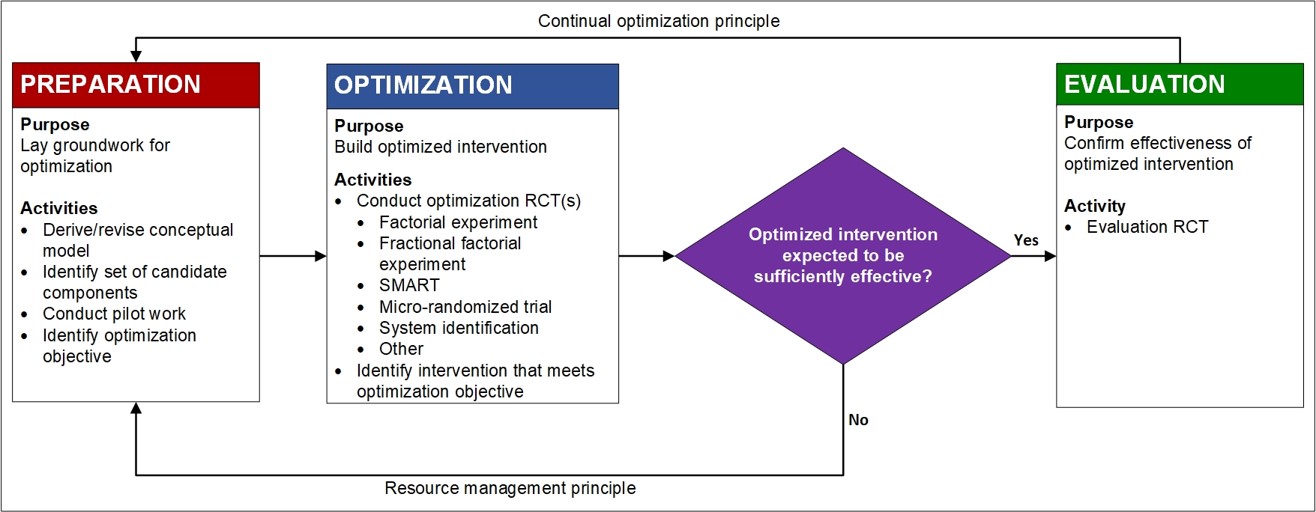Overview of MOST
The purpose of MOST is to arrive at an intervention that achieves intervention EASE by strategically balancing Effectiveness against Affordability (extent to which the intervention is deliverable within budget, and offers a good value), Scalability (extent to which the intervention is implementable in the intended setting with no need for ad hoc modifications), and Efficiency (extent to which the intervention is made up solely of active components, i.e., components that, when included, improve outcomes).
Traditionally, multicomponent interventions were developed and tested using a randomized controlled trial (RCT). MOST also includes an RCT for intervention evaluation, but unlike the classic treatment package approach to intervention development, MOST includes other phases of research before the RCT. These phases of research are aimed at intervention optimization using criteria selected by the scientist. The goal may be to develop a cost-effective intervention, an intervention that achieves a specified level of effectiveness, the briefest intervention that achieves a minimum level of effectiveness, or any other reasonable and explicitly operationalized goal. The MOST framework relies heavily on resource management by strategic use of highly efficient experimental designs. MOST is designed to be practical, and holds out the possibility of achieving more rapid long-run improvement of interventions without requiring a dramatic increase in intervention research resources. (See preface and Chapter 1 of Collins, 2018.)
The phases of MOST
Figure 1 is a flow chart depicting the three phases of MOST: preparation, optimization, and evaluation. MOST is a framework, not an off-the-shelf procedure, so the details can vary somewhat from study to study. This means that a variation on this flow chart may do a better job of describing any particular application of MOST.
Flow chart of the three phases of the multiphase optimization strategy (MOST). Rectangle = action. Diamond = decision. Figure adapted with permission from Collins (2018).
What qualifies as a “multicomponent behavioral intervention”?
A multicomponent behavioral intervention is any intervention with more than one component, in which at least one of the components is behavioral. Here the term behavior is broadly defined to include attitudes, cognitions, and skills. If there is at least one medical component, such as a drug, surgery, or other medical treatment in addition to any behavioral components, the intervention is considered biobehavioral. See Chapter 1 of Collins (2018).
Intervention scientists conduct MOST because they need to make decisions about what components to include in an intervention. If you are asking yourself “Should I include X?” then X can probably be considered a component of the intervention.
As discussed in Chapter 1 in Collins (2018), an intervention component can impact efficacy, effectiveness, and/or cost-effectiveness. To contrast some very different takes on intervention components, read the articles in the Some implementations of MOST section of the recommended reading list.
A note on terminology
The MOST framework has been refined to make it more consistent with the goals and objectives of intervention science, as opposed to engineering. Beginning in about 2014, articles reflect this change. (See preface of Collins, 2018.)
What to cite
The source for a lot of the material included in this website is Collins, L.M. (2018). Optimization of behavioral, biobehavioral, and biomedical interventions: The multiphase optimization strategy (MOST). New York: Springer.
We recommend caution when citing older articles about MOST, because the field has evolved considerably, particularly in the past 10 years.
Further Learning
Whether you are looking for additional support as you prepare a grant proposal involving MOST or practical information helpful in managing your optimization trial, this section provides resources for a deeper dive into intervention optimization.
LET’S STAY IN TOUCH
Join the CADIO Mailing List
Keep up to date with the latest news, events, online courses, and resources from CADIO.
